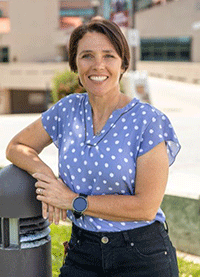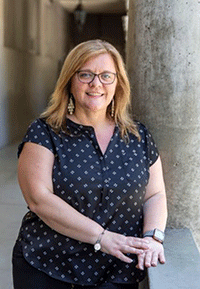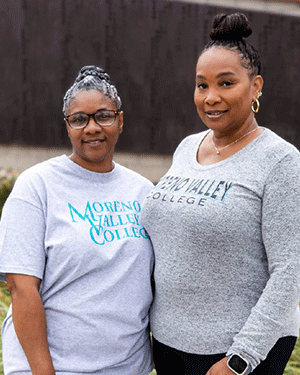Meet Our Faculty

RCCD Distance Education brings you a new Podcast Series centered around online course design and strategy. Visit our Resrouce Shell to watch clips with district personnel. If you would like to be featured on a future podcast, please contact Dean BuShell.
The series is hosted by Michael J. Cennamo, an instructional designer and podcaster at Columbia University. He has been a member of the Columbia University community since 2006—studying, teaching, and working in the field of educational technology. He joined the Center for Veteran Transition and Integration in June 2017 as the Associate Director of Educational Technology.
He engages with RCCD faculty in this podcast series to tackle subjects in distance education that concern RCCD faculty and students. The series has launched with an inaugural interview with Dr. Shawna BuShell, RCCD's Dean of Educational Services and Distance Learning.
Dr. Shawna BúShell (Episode 1)
Dr. Shawna BuShell is the Dean of Educational Services and Distance Learning at Riverside Community College District. She hopes to serve as a vital support system for faculty and staff, enhancing their ability to engage, inspire, and motivate students in online learning environments. She also endeavors to help online students, who face challenges such as isolation, depression, and disconnection from campus life, by implementing initiatives grounded in research and best practices.
Dee Thompson (Episode 2)
Dee Thompson teaches Computer Information Systems applications, theory, and cyber security courses at Riverside City College. She also leads the Soulful Circle program, a supportive online community dedicated to fostering the mental well-being and academic success of African American women of the Riverside Community College District.
Dr. Corey Timberlake (Episode 3)
Dr. Corey Timberlake teaches sociology and ethnic studies courses at Riverside City College. He is the Director of RCC Umoja, a program dedicated to enhancing the cultural and educational experience of African American students at the college.
Coming Soon! Dr. Mary Rankin (Episode 4)

Moreno Valley College Faculty Spotlight
Darrylon Evans & Melissa Thompson
Early Childhood Education/HESBS
Favorite Online Instructional Tool?
We have several! Flipgrid, Canvas Studio, Play Posit and Tech Connect Zoom Appts. Students have the opportunity to showcase their talents and skills outside of traditionally writing papers.
They create beautiful videos with add-on features, they are able to interact with video content based on specific questions provided within the tool for them; it is real-time hands-on experiences for them.
Students are able to connect with both of us outside classroom hours and discuss assignments
or just vent about whatever is bothering them. The tools we use in our courses vary
and they provide positive interactions for our students.
What's one area of teaching online that used to pose a challenge for you?
Evans: I was given valuable feedback regarding the layout of my modules. I found it challenging to incorporate intro/outro sections.
Thompson: Providing feedback to all students in all courses in a timely matter and including an Into and Outro page.
We both joined the DE Den and focused on learning new concepts and strategies. We became very familiar with the Commons area of Canvas, I (Evans) attended every single DE Den workshop/meeting and asked questions. We made a huge improvement by utilizing DesignPLUS and creating and designing robust rubrics and using the comment manager.
Whatever we can do to make learning clearer for our students, we are willing to do
it. The intro and outro pages gave students an idea of what we would be discussing
in that module: objectives, learning goals, content, mini lectures, PowerPoint slides,
resource articles, review of content covered and ways take a deeper dive into the
strategies and information covered in that module. The success of our students is
our success.
What's something you do in your online or hybrid course(s) that you're proud of?
Evans: Building a community online with students. I do this by assigning group work and discussions where students are placed in smaller pods of their choice often and allowed to collaborate with one another. Students share in the end of semester survey I provide how much they enjoyed getting to know their peers.
Thompson: The organization and the course content I provide to our students. When I started online, it was hard for me to navigate through an online course as a student. As a professor, I'm keenly aware that making the course accessible, easy to navigate and content rich is the key to motivating students, creating a positive online community and keeping students engaged.

Norco College Faculty Spotlight
Caroline Hutchings
Mathematics
Favorite course to teach?
Statistics.
What's one area of teaching online that used to pose a challenge for you?
When I first started teaching hybrid, I tried to squeeze all the same material in half the amount of class time.
The material I couldn't fit in I left to the students to work through on their own.
The pandemic really changed the way I view online and hybrid classrooms. By moving
everything online, it gave me a reason to find new tools to make teaching online easier
and more engaging for the students.
What's an area of online or hybrid teaching that has been exciting for you or your discipline?
The most exciting area of hybrid/online teaching for me has been the discovery of all the apps to increase engagement, motivation, and interaction with the students, such as Kahoot! Quizzes and PlayPosit. "If I can do it in the classroom, I can do it online" became my way of thinking about hybrid and online learning.
A recent change that has made a big difference for me is moving the majority of my lectures online and using PlayPosit to embed comprehension questions for the students in the lectures. I wasn't sure how the students would respond, but PlayPosit has lots of options to adjust the experience for the students to fit both our needs. The student feedback has been very positive, the questions help them know what to focus on in the lectures and keeps them from 'zoning out.'
With my online students that don't have the opportunity to physically be in a classroom
together, I still wanted them to have the opportunity to work in groups but it needed
to be on their time schedule. I found VoiceThread to be a great tool for asynchronous
group work. Students record themselves solving problems and are able to share with
the group. The group can review these problems at their convenience and provide feedback.
Is there an area you're hoping to explore more in the upcoming academic year?
With all the options for feedback, engagement, assessment, and the equation editors that are now available, the list of options is endless. In fact, at times the list of options can be overwhelming, but I have found by making appointments with our DE Course Developers, I can quickly get guidance on tools that will help me accomplish what I have in mind. We even had a DE Course Developer meet with a group of math faculty to give an overview of some of the tools available! I hope to continue exploring and improving in order to engage and enlighten the students, and maybe convince them to become statisticians!

Riverside City College Faculty Spotlight
Tina Stavropoulos
English, LHSS
Courses:
English 1A, English 1B, English 91
Favorite Canvas Tool?
The first that came to mind was the student annotation assignment option in Canvas.
As an English instructor who uses Open Educational Resources (OER) almost exclusively,
I want students to read the assigned texts and engage with them.
What's something you do in your online or hybrid course(s) that you're proud of?
When completing the CVC- OEI Humanizing Challenge through @One during the summer of 2020, I was introduced to the liquid syllabus. I was too intimidated by the process to create my own, but I was intrigued by the prospect.
When I took the Equity & Culturally Responsive Online Teaching course through RCCD and @One the following year, however, I was required to create one through Google sites for our final assignment, and I was glad it was required since it forced me to overcome my intimidation and get to work.
Having this pre-course contact in addition to my welcome email to students helps them
as they approach our intimidating composition courses. They feel welcomed into our
classes through the liquid syllabus, ideally. As we know, the affective domain is
vital in learning. I was also delighted to learn that faculty can create a liquid
syllabus in Canvas with the help of a Course Developer instead of trying to tackle
this challenge alone.
What's one area of teaching online that used to pose a challenge for you?
I struggle to create Canvas Pages and Assignments that are aesthetically appealing. While I was always able to refine the clarity of my directions, due dates, etcetera, I found them very bland visually. Thanks to a DE Course Developer's presentation during our Community of Practice, I was introduced to the DesignPLUS Templates.
While I am aware that we were sent the information about these tools before, there is something about seeing that demonstrated in a hands-on session and then presenting that information and samples to colleagues that inspires others to utilize the tools.
My goal over the summer is to take my existing pages and assignments and bring some
of that color and some of those tabs while also maintaining the accessibility of the
documents. This will make those long blocks of information easier to navigate and
digest for students.
Is there an area you're hoping to explore more in the upcoming academic year?
Accessibility has always been an area where I want to learn more and strive to perfect my presentation of materials. Whether that is captioning videos, tagging PDFs, or creating accessible PowerPoints, I want all my materials to be accessible for all our students.


